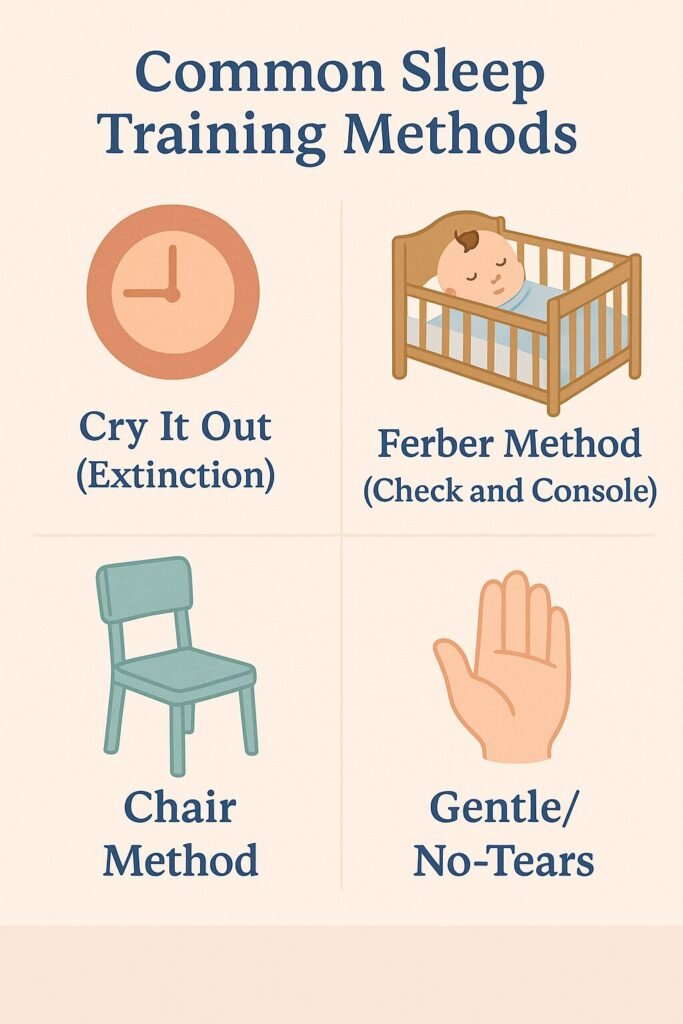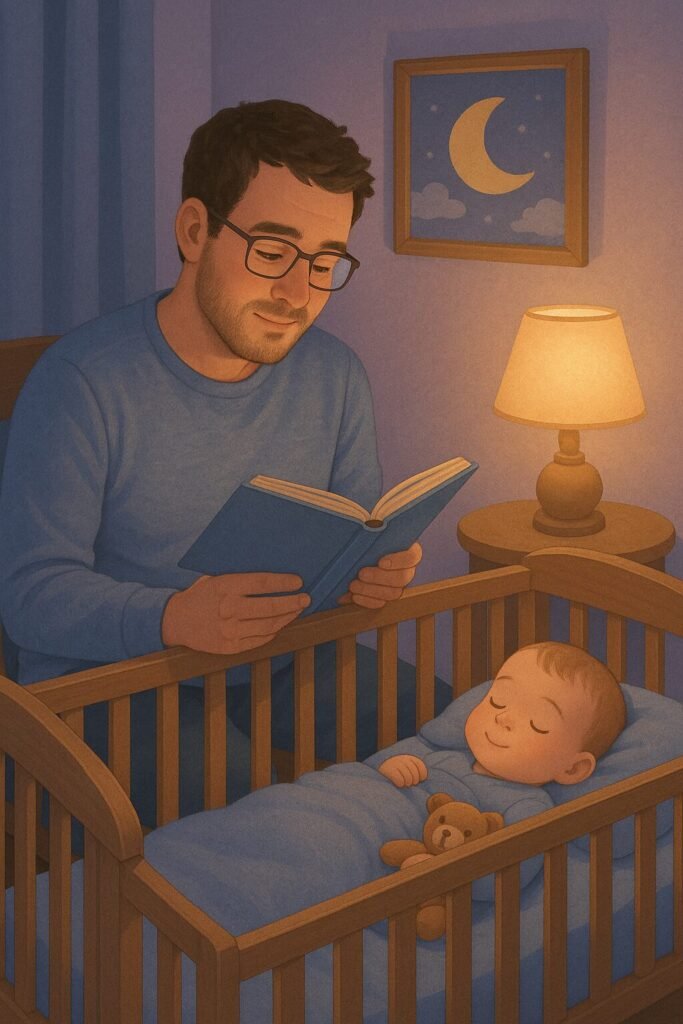Intro:
Getting your infant asleep during the night can seem like an endless struggle. I have been there, wondering if I was doing it all wrong, pacing the room with weary eyes and clutching my sobbing infant. The good news is that you are not alone and that things do improve. Supported by actual studies and personal experience, this guide will bring you through all I have discovered about sleep training and nighttime rituals.

Why Sleep Training Matters
Sleep is more than just rest. For babies, it helps brain development, growth, and emotional balance. For us parents, it helps us function, stay patient, and enjoy parenting more.
Before I started sleep training my baby, nights were chaotic. She’d wake up every two hours. But with a consistent routine, everything changed.
More on why sleep is important:
Babies who get enough sleep cry less, seem happier, and have stronger immune systems. Better sleep for parents means less worry and more vitality to savor those priceless times with their child. Sleep is not only a respite; it’s also a component of your baby’s normal development—physical, emotional, and psychological..

Common Sleep Training Methods (Tried and Tested)
1. Cry It Out (Extinction Method)
Put the baby to bed and let them fall asleep without help—even if they cry.
My experience:
Tough at first, but after a few nights, my baby slept through.
Tips:
- Make sure baby is fed and clean
- Stick to your plan
- Use a monitor for peace of mind
2. Ferber Method (Check and Console)
Let the baby cry for a few minutes, then check in without picking them up. Increase time between check-ins gradually.
Why parents love it:
Feels gentler than full cry-it-out.
Tips:
- Follow a schedule (3, 5, 10 mins)
- Keep check-ins short and soothing
3. Chair Method
Sit near the baby’s crib and move farther away each night until they fall asleep on their own.
Worked well for us for 9 months.
Tips:
- Limit talking and eye contact
- Stay calm and consistent
4. Gentle/No-Tears Methods
Respond quickly and gently help the baby fall asleep without much crying.
Best for newborns.
Tips:
- Calm environment
- Use “pick-up, put-down” method
The Magic of a Bedtime Routine
Routine is powerful. It helps signal to your baby that it’s time for sleep.
Our Bedtime Routine:
- Warm bath
- Pajamas and diaper
- Short bedtime story
- Lullaby or music
- Lights out with a night light
Result:
Within two weeks, bedtime became smooth and predictable.
More on routines:
Babies love predictability—it makes them feel safe. Try to start your routine around the same time every night. Keep the activities calm and slow down as bedtime nears. Avoid overstimulation like loud noises or bright lights, which can make falling asleep harder.

Dealing with Sleep Regressions
Sleep regressions often show up at:
- 4 months
- 9 months
- 18 months
Common Signs:
- Frequent night wakings
- Fussiness
- Shorter naps
Tips that helped us:
- Stick to the routine
- Avoid new sleep habits
- Be patient—it usually passes in 2-3 weeks
Additional advice:
Sleep regressions can feel like you’re back at square one, but try to remember this phase is temporary. Your baby’s brain is growing fast, which sometimes disrupts sleep. Keep your calm, maintain consistency, and soon you’ll see improvements again.

Helpful Sleep Tools
- White Noise Machine
Blocks background noise. It creates a soothing environment similar to the womb. - Blackout Curtains
Keep the room dark and sleep-friendly, especially during daytime naps. - Lullaby Playlist
Consistent music signals bedtime and helps your baby relax. - Sunset Lamp
Mimics natural dimming light to relax your baby’s brain and prepare for sleep. - Smart Bassinets (e.g., Snoo)
Automatically rocks and soothes your baby based on their cries, helping them fall back asleep faster.
Sleep Safety 101
Follow the ABCs:
- Alone (baby sleeps in their own crib)
- Back (always put baby on their back to sleep)
- Crib (or bassinet) with a firm mattress
Other Tips:
- No loose blankets, pillows, or stuffed toys in the crib
- Use a firm mattress to avoid suffocation risks
- Room-share (not bed-share) for at least 6–12 months to monitor your baby safely
Why this matters:
Following these safety guidelines lowers the risk of Sudden Infant Death Syndrome (SIDS) and ensures your baby sleeps in a safe environment.

Screen Time and Sleep
Screens can interrupt melatonin production, the hormone that tells your body it’s time to sleep.
What We Did:
- No screens 1 hour before bed
- Replaced TV with reading
- Set daytime screen limits
Result:
Faster falling asleep and calmer evenings.
More tips:
Blue light from phones, tablets, and TVs tricks the brain into thinking it’s daytime. Even if your baby is not watching screens directly, the household screen use can impact their sleep environment. Aim for calming activities like reading, cuddling, or soft music instead.
Co-Sleeping and Culture
In many cultures, co-sleeping is the norm.
Safer Co-Sleeping Tips:
- Avoid soft bedding to prevent suffocation
- No smoking or alcohol around the baby
- Consider a sidecar crib for safer proximity
What I learned:
Co-sleeping can help with night feeding and bonding, but it’s important to do it safely. If you choose to co-sleep, make sure you understand the risks and follow safety guidelines closely.
When to Ask for Help
Sleep issues can be tough. If nothing works, or your health is suffering, reach out.
Support Options:
- Pediatricians
- Certified sleep consultants
- Parenting groups (online and local)
Remember:
There’s no shame in asking for help. Sleep training can be overwhelming, and professionals can offer personalized advice and support.
Extra Tips for Parents:
- Be flexible: Sometimes your baby may have an off night, and that’s okay. Don’t stress over occasional setbacks.
- Take care of yourself: Rest when your baby naps and ask for help from friends or family. Your well-being matters too.
- Celebrate small wins: Every hour your baby sleeps longer is progress—be proud of that!

Final Thoughts
Sleep training is about teaching, not forcing. Every child is different. What worked for me might not work for you—and that’s perfectly okay.
Stay consistent, trust yourself, and celebrate the small wins. You’re doing a great job, and one night at a time, it will get better.
(FAQs)
Q1: When should I start sleep training my baby?
Most experts suggest starting between 4 to 6 months old, when babies develop more regular sleep patterns. But every baby is different—some may be ready earlier or later.
Q2: What if my baby cries too much during sleep training?
It’s normal to feel heartbroken, but remember crying is how babies communicate. Choose a method you’re comfortable with, and stay consistent. If it feels too hard, try a gentler approach or take breaks.
Q3: How long does sleep training usually take?
It varies, but many parents see improvements within 1 to 3 weeks. Some babies take longer, so patience is key.
Q4: Can sleep regressions undo progress?
Yes, regressions are temporary disruptions often caused by growth or developmental milestones. Stick to your routine, and your baby will get back on track.
Q5: Is co-sleeping unsafe?
Co-sleeping can be safe if done carefully—no soft bedding, no smoking or alcohol, and ideally using a sidecar crib. Always follow safety guidelines.
Q6: What if my baby refuses naps?
Try keeping nap times consistent, create a quiet and dark environment, and watch for sleepy cues like rubbing eyes or yawning.
Q7: Should I wake my baby for feedings at night?
For newborns under 3 months, yes, to support growth. After that, if your baby is healthy and gaining weight, they can gradually sleep longer stretches.
Quick Tips for Better Baby Sleep
- Keep bedtime and wake-up times consistent every day.
- Create a calm, dimly lit environment 30 minutes before sleep.
- Avoid stimulating activities close to bedtime.
- Use a white noise machine to mask household sounds.
- Dress your baby comfortably, not too hot or cold.
- Stay calm and patient during night wakings.
- Try to soothe your baby without picking them up when possible.
- Keep feeding, changing, and soothing quickly and quiet at night.


Pingback: Break Generational Parenting Patterns – Real Guide
I very delighted to find this internet site on bing, just what I was searching for as well saved to fav